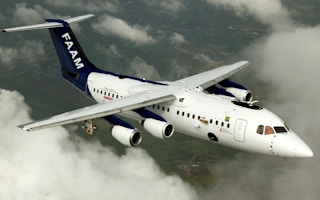British scientists are using aircraft packed with high-tech air monitoring equipment to predict what is happening in the lower atmosphere as the climate warms.
While the extra heat in the oceans and on land, which can be measured, is known to add energy to the atmosphere, the precise effect this has on clouds, storms and where rainfall will be generated remains largely a mystery.
As well as the problems created by greenhouse gas emissions, air pollution from traffic, industry, burning forests and the vast palm oil plantations in the tropics are all changing rainfall patterns.
The critical part of the atmosphere for creating the day-to-day weather that affects food supplies and generates increasingly destructive storms is the first kilometre (3,280 feet) above the ground.
It is possible to measure some of the changes that are happening from satellites and ground observation stations, but the only way to find out precisely what is going on is to fly through the clouds and measure what they contain.
Both the US and the UK have developed airborne laboratories where scientists can feed air directly from intakes in the aircraft’s nose and sides into onboard equipment to measure exactly what is happening in the atmosphere outside.
Desert dust
One of these aircraft is the BAe 146-301 large Atmospheric Research Aircraft (ARA) based at Cranfield University in central England. The aircraft has been used this year to study the mineral dust coming off the Sahara, which heads westward across the Atlantic and provides the anchor for water droplets that turn into giant cumulus clouds.
The team has been flying through the clouds of dense dust over the Cape Verde archipelago off the coast of West Africa to try to understand how the process works – a key to predicting the hurricanes that will later spiral across the Atlantic and hit the Caribbean and the US.
The plane has been on show this week at the Facility for Airborne Atmospheric Measurements (FAAM) at Cranfield. It is the largest plane in the fleet based there for use in atmospheric research, part of the National Centre for Atmospheric Science. The aircraft can carry four tons of scientific equipment, three crew and 12 scientists.
It has also been used to measure the methane escaping from the Arctic as the permafrost melts, the effect on clouds of pollution from New Delhi and Beijing of rainfall in the region, and ash from volcanic eruptions. It can even head through storm clouds to check the devastation they can cause as they develop, and can fly at heights from 35,000 feet (10,670m) to 50 ft (15m), measuring the atmosphere once every second.
The aircraft and the research it makes possible are both funded by the UK’s Natural Environment Research Council (NERC). Professor Iain Gillespie, NERC’s director of science, says the link between manmade air pollution and premature deaths among local populations is a central part of their studies. In 2012 there were 3.7 million premature deaths worldwide because of air pollution. Low and middle-income countries were the worst affected, suffering 88% of the deaths.
Asian scourge
Even the UK, with relatively low pollution levels and 60 million people, records 29,000 of these premature deaths annually. Average life expectancy is lowered by seven months, and the annual cost to the economy is £20 billion. The loss of life in India and China, where air pollution is often 40 times above the World Health Organisation danger limit, is in the millions.
To investigate the link between this air pollution and what is happening in the clouds, ARA counts the particles from diesel engines and the hydrocarbons from industrial processes, and checks how they are affecting the size and composition of the droplets of water and ice in clouds and the rainfall they produce.
Professor Gillespie said: “This is particularly important in the case of the South Asian monsoon, which provides 80% of the rainfall to feed a billion people, yet might be adversely affected by manmade pollution.”
Other manmade effects on the atmosphere and rainfall are also being studied. For example palm oil plantations in Borneo produce three to four times as much isoprene, an aerosol associated with mist and cloud formation, as the rainforests felled to make room for them. The link between this change of land use and rainfall in the region is still being investigated.










